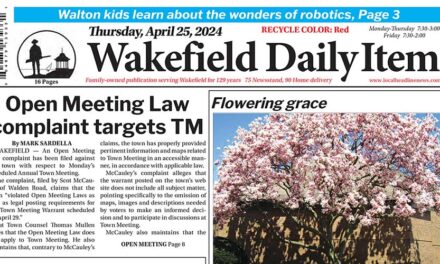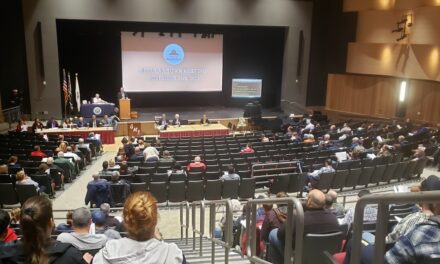Published in the October 26, 2016 edition
By MARK SARDELLA
WAKEFIELD — Based on state-issued school accountability ratings, Wakefield schools are continuing to perform at a high level, according to a “Wakefield Public Schools PARCC and MCAS Update” presented to the School Committee last night by Assistant Superintendent of Schools Douglas Lyons.
The results of the latest MCAS and PARCC student assessment tests came out this month along with school accountability level reports.
“Schools are rated in the state based on assessment performance,” Lyons said. He explained that under the Department of Elementary and Secondary Education (DESE) ratings, schools are classified into one of five accountability and assistance levels, with the highest performing in Level 1 and lowest performing in Level 5. Massachusetts also uses the Progress and Performance Index (PPI) to assess the improvement of each district and school toward its own targets.
Lyons said that 80 percent of the schools in the state perform at the two highest levels (1 and 2) and all Wakefield Schools are performing at Level 1 or 2. Lyons explained that if a district’s schools are performing at either a Level 1 or Level 2, the DESE does not target that district for a lot of engagement or assistance, because it trusts that students are being well served.
Lyons said that in 2015, Wakefield had one school, the Walton Elementary School, in Level 1 and five schools in the Level 2 category (the Dolbeare, Woodville and Greenwood elementary schools, the Galvin Middle School and Wakefield Memorial High School.
In 2016, he noted, two more schools — the Dolbeare and Woodville — had risen to Level 1 along with the Walton. The High School, the Galvin and the Greenwood Schools retained their Level 2 rating.
Lyons summarized the areas of improvement noted for each school in the state rankings.
• The Dolbeare made gains in the High Needs and Special Education Sub Group.
• The Galvin Middle School made gains in the High Needs and Special Education Sub Groups
• Greenwood made gains made in the High Needs Sub Group.
• WMHS decreased the number of students in the Warning category.
• Walton had a noteworthy PPI of 97 out of 100.
• Woodville gains were made in the High Needs Sub Group.
(The High Needs Sub Group includes English Language Learners and economically disadvantaged students.)
Lyons also reviewed the most recent MCAS and PARCC scores for Wakefield. In PARCC, he said, the goal is to get students performing at Level 4 (meets expectations) or Level 5 exceeds expectations). In MCAS the goal is for students to perform at either the “proficient” or “advanced” level.
He said that from 2015 to 2016, Wakefield students in Grades 3 through 8 had showed “remarkable” improvement on the PARCC Mathematics assessment.
In 2015, 59 percent of third-graders scored in levels 4 and 5. But in 2016, 68 percent of Wakefield students in Grade 3 scored in the top two levels, a 9 percent improvement.
In 2015, 50 percent of Grade 4 students in Wakefield scored in Levels 4 and 5 of the PARCC Math assessment. But in 2016, 70 percent of local fourth-graders were in the top two levels.
Grade 5 students scoring in the meets or exceeds expectations categories in math went from 40 percent in 2015 to 46.6 percent in 2016.
In grade 6, students scoring on the top two levels in math went from 47 percent in 2015 to 51.9 percent in 2016.
In 2015, 52 percent of local seventh-graders scored in the two highest levels in math, but in 2016, 59.6 percent did.
For eighth-graders, 47 percent scored in Levels 4 and 5 on the PARCC math assessment in 2015 but in 2016 that number jumped to 58.7 percent.
Lyons explained that the improvement was not quite so dramatic in the PARCC English Language Arts (ELA) test, probably because Wakefield students were already starting at a higher level.
The percentages of students scoring in top two levels in the PARCC ELA test from 2015 to 2016 for grades 3-8 were as follows:
Grade 3 – 54 percent in 2015, 57.1 percent in 2016.
Grade 4 – 65 percent in 2015, 66.5 percent in 2016.
Grade 5 – 58 percent in 2015, 62 percent in 2016.
Grade 6 – 58 percent in 2015, 60.3 percent in 2016.
Grade 7 – 69 percent in 2015, 71.6 percent in 2016.
Grade 8 – 50 percent in 2015, 64.4 percent in 2016.
Moving to the 10th Grade math MCAS scores, Lyons noted that 84 percent of Wakefield students performed at either the “advanced” or “proficient” level. Those results are within a few percentage points of the 2015 results when 88 percent scored in the top two levels.
In the 2016 Grade 10 ELA MCAS, 94 percent of Wakefield students scored either “advanced” or “proficient,” compared to 96 percent in 2015.
Lyons said that the Science, Technology and Engineering MCAS is given in the fifth, eighth and 10th grades.
In Wakefield 46 percent of fifth-graders scored proficient or higher on Science Technology and Engineering MCAS, compared to 47 percent of fifth-graders statewide.
Thirty-eight percent of local eighth-graders score proficient or higher compared to 41 percent of their statewide counterparts.
For 10th graders, 78 percent scored in the top two levels, compared to 73 percent statewide.
Combining all the grades taking the Science Technology and Engineering MCAS, 53 percent of Wakefield students were in the top categories, compared to 54 percent statewide.
Lyons said that the new “MCAS 2.0,” combining elements of the MCAS and PARCC tests, is being developed now. High Schools will continue to use the traditional MCAS through 2020, he added. All new assessments will be computer-based, with the goal of 100 percent computer-based testing by 2019.




